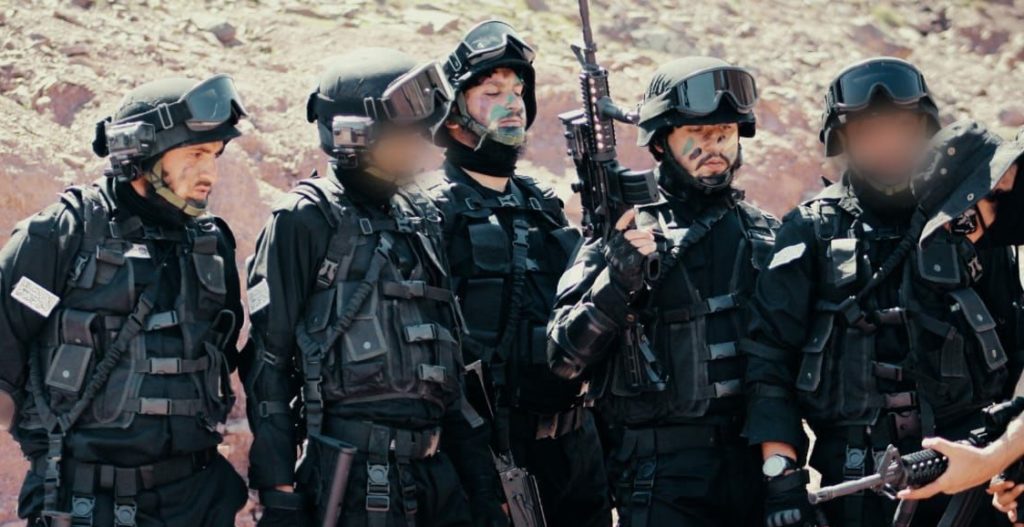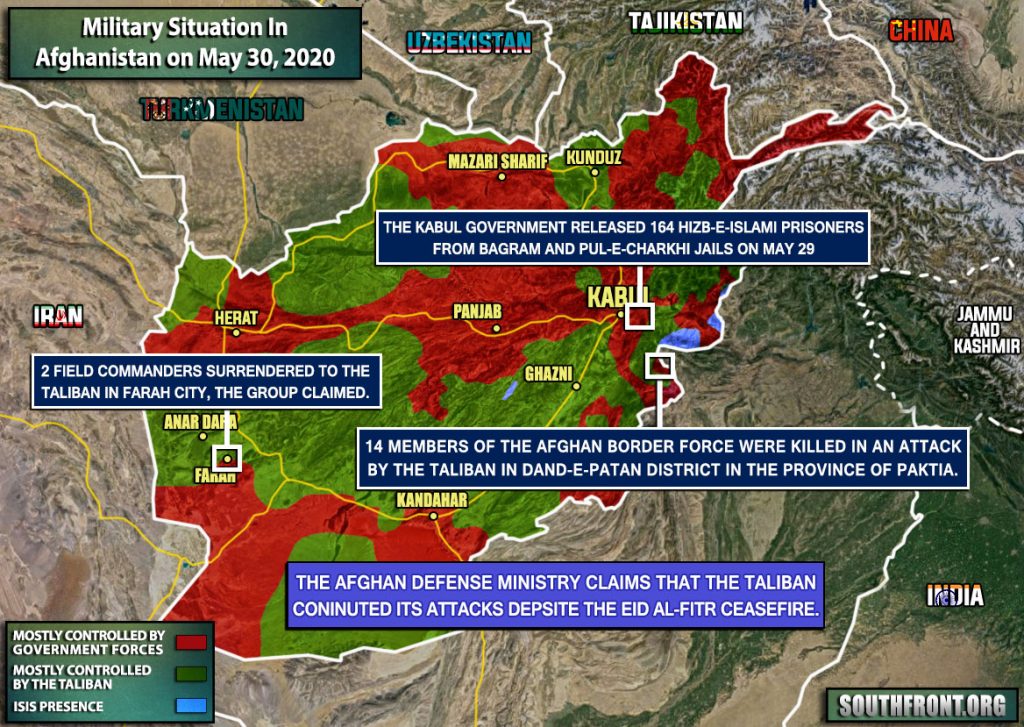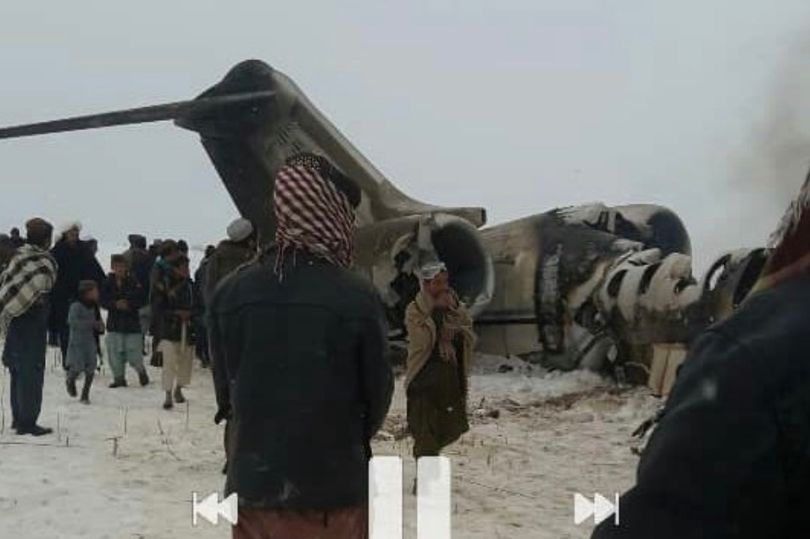DEAR FRIENDS. IF YOU LIKE THIS TYPE OF ANALYTICAL CONTENT, SUPPORT OUR WORK:
PayPal: southfront@internet.ru
Donation alerts: https://donationalerts.com/r/southfront
Gumroad: https://gumroad.com/southfront
Or via: http://southfront.org/donate/ or via: https://www.patreon.com/southfront,
BTC: 3Gbs4rjcVUtQd8p3CiFUCxPLZwRqurezRZ,
BCH ABC: qpf2cphc5dkuclkqur7lhj2yuqq9pk3hmukle77vhq,
ETH: 0x9f4cda013e354b8fc285bf4b9a60460cee7f7ea9
Section 1
The conflict in Afghanistan spans over decades of history. The region itself is the scene of geopolitical confrontation for at least several centuries.
In the last 50 years, there were four main stages of the international conflict in Afghanistan:
- The Afghan conflict 1979-1989 – a military conflict on the territory of Afghanistan between government forces (supported by a limited contingent of Soviet troops) and armed groups of Afghan mujahideen, that were receiving political, financial, material and military support from the leading NATO member states, China and the conservative Islamic world.
- The Civil War of 1989 – 2001. This is an ongoing conflict of intra-Afghan forces supported by foreign powers. This period can be divided into three parts.
- The Afghanistan War 2001-2014. This is a military conflict between the US-led military coalition (International Security Assistance Force; ISAF) and the Taliban movement, which previously controlled most of Afghanistan. The Northern Alliance and then the US-controlled Kabul government supported actions of the ISAF. In fact, the US intervention in Afghanistan with the occupation of a large part of the country’s territory took place under the pretext of “the fight against terrorism”.
- The Afghanistan War 2015 – present time. This is an armed conflict between the Kabul government, the United States and NATO forces on the one side, and the Taliban and militants from various radical groups on the other side. It entered into an acute phase immediately after the withdrawal of the main contingent of NATO troops from Afghanistan.
Click to see the full-size image
Section 2
Intra-Afghan factions:
- The Kabul-based government. It is led by President Ashraf Ghani and relies on a part of the Pashtun population living in big cities, a part of the forces of the former Northern Alliance, (for example forces and political influence of an ethnic Uzbek, General Abdul Rashid Do‘stum) and ethnic and religious minorities. However, the corner stone of the Kabul influence is the support that it receives from the United States and other Western countries. Kabul represents the conditionally “liberal” part of the Afghan society and has no real support and popularity among the general population.
- Hezb-e-Islami Gulbuddin. Its head is the former leader of mujahideens, Gulbuddin Hekmatyar. The party’s strategy is the Islamic revolution. The ideology is close to that of the Muslim Brotherhood. The party relies on the support of part of the rural Pashtun population and has close ties with Pakistan. Currently, it is not carrying out open hostilities against the central government. The population of Kabul has an extremely negatively position towards the party.
- The Taliban movement. As of May 2020, it seems to have the greatest support among the population of the country. Its support rests in large shares of the Pashtun population. It has a branched structure and a very strong military organization. It is actively fighting against foreign invaders and the Kabul government.
- The Haqqani network. This group is based at the border with Pakistan and is involved in an active armed struggle. It has contacts and coordinates its efforts with the Taliban and even foreign terrorist groups like Jaish-e-Mohammed, Lashkar-e-Taiba, the Islamic Movement of Uzbekistan. Additionally, the Haqqani network allegedly has organizational and ideological links with ISIS>
- ISIS – Khorasan Province. ISIS cells in Afghanistan have been increasing their activity. Their popularity among the poorest part of the population is growing.
- Al-Qaeda. Groups linked with al-Qaeda are a separate factor of instability. In the last year, they have established close ties radicals in Syria’s Idlib and Turkic radical organizations in the Central Asian region.
- Local field commanders of the “North”. First of all, these are Tajik and Turkmen field commanders. Most of them support one or another radical organization. They rely on ethnic communities and local armed groups.
Section 3
External forces pursuing an active policy in the region:
- The United States and NATO member states provide a coordinated policy led by Washington. In the current conditions, it makes sense to view separately the activity of the United Kingdom, which largely pursues the policy of the US democratic establishment.
- The People’s Republic of China traditionally follows two vectors: economic and political. In the field of security and the fight against terrorism, the position of China coincides with the interests of the Collective Security Treaty Organization member states.
- The Russian Federation and Kazakhstan, and even more broadly the CSTO, seek to ensure stability of the region, promoting the concept of the Eurasian unity.
- Pakistan traditional supports the main Pashtun population of Afghanistan and has a supportive attitude towards the Taliban. Some Pakistani elites support the expansion of ISIS in Afghanistan. An example is the support provided to the Haqqani network.
- Saudi Arabia supports forces ideologically close to al-Qaeda as a tool of its influence in the Islamic world.
- Qatar supports forces ideologically close to ISIS. It is an opponent of Saudi Arabia’s influence.
- Turkey support the Turkic population of Afghanistan, pro-Turkish groups and promotes the neo-Ottoman agenda in the region.
- International terrorist organizations as independent actors in the region.
Section 4
Key developments of 2019:
- January 27 – The United States achieved a progress in peace negotiations with the Taliban. These were confirmed by the both sides: U.S. Special Representative for Afghanistan Reconciliation Zalmay Khalilzad and Zabiullah Mujahid, a spokesman for the Taliban.
- March 2 – The Taliban stormed the Sharobak base killing at least 25 persons. The Taliban claims that about 400 US and Afghan troops were killed.
- March 30 – The Taliban seized a district in northeastern Afghanistan. 14 people died.
- August 24 – The Taliban and the United States reached an agreement on the schedule of the foreign troop withdrawal from Afghanistan.
- October 25 – At least 100 Taliban fighters were killed in a special operation in the province of Baghlan. Government forces retook Dahana i Ghuri District, which was in the hands of the Taliban for almost 3 years.
Key developments of 2020:
- February 29 – The Taliban and the United States signed a peace deal in the Qatari capital, Doha. Under the agreement, the United States and NATO will fully withdraw their forces from Afghanistan in 14 months after signing the agreement. The Taliban, on its side, must stop attacks on the territory of Afghanistan.
- March 2 – The Taliban announced the resumption of operations against the Kabul government. 3 people died and 11 others were injured in an explosion in the east of the country.
- March 11 – The United Kingdom decided to withdraw 330 personnel from Afghanistan by mid-July.
- May 12 – 24 people were killed and 16 others were injured in an attack of gunmen on a hospital in Kabul. An explosion erupted during the funeral of a police head killing 32 people and injuring 103 others. President Ashraf Ghani ordered to resume operations against the Taliban in response to regular attacks.
Section 5
In order to demonstrate possible effective directions for resolving the conflict in Afghanistan, it is advisable to divide the main actors into groups with a similar nature of interests.
There are four such groups:
- The United States and NATO member states. This group of actors is not interested in stabilizing Afghanistan as an independent state. They do not have economic interests in Afghanistan, in general, and there is no positive motivation for their activities in the region. They see Afghanistan as a point of instability and a bridgehead of destructive impact on Russia and China.
- The diametrically opposed motives are guided by China, Russia and the countries adjacent to Afghanistan (primarily the CSTO countries and Iran). For this group of actors, the stability of the region is a key factor of national security. Even Pakistan, whose elites are not homogeneous, generally supports the positivist agenda for Afghanistan. These states also have economic interests in Afghanistan. A separate problem is the fight against drug trafficking. Consequently, this group of actors seek to improve the socio-economic situation in Afghanistan.
- The third group of actors includes traditional Islamic extra-regional states, pursuing their own, often narrow interests and those regimes that consider Afghanistan as a springboard for implementation or an element of their geopolitical constructs. These are Saudi Arabia, Qatar, the UAE, Turkey.
- International terrorist organizations centered around two constructs: ISIS and Al-Qaeda. These forces consider Afghanistan as a base and a springboard for extending their activities to the Central Asia and the Middle East region, and then Russia, China, India, etc.
Section 6
The interests of the various groups operating in Afghanistan, the current situation and the history of the conflict demonstrate that it is difficult, but not impossible, to stabilize the political situation in the region.
Peaceful settlement can be achieved by implementing scenarios A) or B), or various configurations between A) and B):
A) through the process of integrated following through on aspirations and interests:
1. the bulk of the population;
2. The key domestic political forces;
3. The key external actors.
B) in the event of a significant transformation of ideology, military, economic, political potential:
1. the bulk of the population;
2. key domestic political forces;
3. The key external actors.
For example, stabilization of the political situation in Afghanistan is possible under the following actions and conditions:
- The legalization of the political wing of the Taliban;
- The involvement of a significant number of Taliban functionaries in the general Afghan authorities, primarily in the justice system and the government;
- Softening the position of the Taliban towards national and religious minorities of Afghanistan;
- Inclusion in the hierarchy of power and legitimization of the regional leaders of the Taliban through the recognition of the rights of the heads of provinces and regions in those areas that are already under the control of the movement;
- The withdrawal of foreign troops from Afghanistan. This could happen, for example, due to a decrease of the US economic potential and/or a change in the geopolitical balance of power.
- Creation and implementation of a program of foreign economic assistance to Afghanistan with an emphasis on a direct financing of infrastructure projects through the creation of a special international fund. The actual volume of the program should be in an amount of no less than $25 billion. The term would be 5 years. The signatories of the fund should include China, the United States, Russia, Iran, Turkey, Kazakhstan, Pakistan, Germany, France. Other Western States could also participate, under the conditions of an altered geopolitical situation and if the US foregoes its strategy of spreading “controlled chaos” in the region.
- Granting autonomy rights to the regions of compact residence of national and religious minorities (in one way or another). The main factor would be their right to form the local judicial system and security forces, or to appoint their own leadership.
- Connecting the expanded security forces of Afghanistan to the procedures for ensuring security and the fight against terrorism and extremism in the appropriate formats of the CSTO and SCO.







” The United States and NATO member states do not have economic interests in Afghanistan, but in general, there is no positive motivation for their activities in the region. ”
What about the poppy / heroin trade ? What about the rare earth and other minerals ? What about control of gas transit pipelines ?
What about the poppy / heroin trade ? What about the rare earth and other minerals ? What about control of gas transit pipelines ?
Spot on
Forgot to include the negative role being played by India in Afghanistan
India is having more problems with monkeys. A gang of monkeys assaulted an employee of a medical college in northern India and snatched blood samples of coronavirus-positive patients from
him, causing panic among locals.
Thorough analysis and overview over 40 years. Good prescriptions for a way forward.
Good work by South Front, which is why I support the organization. I rely on such reports
to stay informed about the flux of people and events far afield yet in an increasingly smaller
world, or so it seems.
AmeriKKKa is a failed shithole that is burning and it needs these lardass military losers to go back and kill the demonstrators in the mean streets.
When I hit American democratic establishment, I was ejected from reading further..
talibans want the yankee-twats gone and it ain’t much the white house twat can do about it although he’s holding out for some kind of deal as the bill gets bigger and which will allow him to claim some kind of victory to sell to the basically dumb and obese trailer trash in the fly over states and they will vote him in for another disastrous 4 years, unless of course it dawns in the stupid left behind trash that the catastrophe that the covid-19 is is entirely due to the failure of the white house to take proper measures.
not a peep about iran wich absorbed the bulk of afghan refugees.